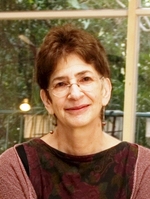Lexical semantics, as a subfield of linguistic semantics, is the study of word meanings. It includes the study of how words structure their meaning, how they act in grammar and compositionality, and the relationships between the distinct senses and uses of a word.
Irene Roswitha Heim is a linguist and a leading specialist in semantics. She was a professor at the University of Texas at Austin and UCLA before moving to the Massachusetts Institute of Technology in 1989, where she is Professor Emerita of Linguistics. She served as Head of the Linguistics Section of the Department of Linguistics and Philosophy.
In generative grammar and related frameworks, a node in a parse tree c-commands its sister node and all of its sister's descendants. In these frameworks, c-command plays a central role in defining and constraining operations such as syntactic movement, binding, and scope. Tanya Reinhart introduced c-command in 1976 as a key component of her theory of anaphora. The term is short for "constituent command".
In formal linguistics, discourse representation theory (DRT) is a framework for exploring meaning under a formal semantics approach. One of the main differences between DRT-style approaches and traditional Montagovian approaches is that DRT includes a level of abstract mental representations within its formalism, which gives it an intrinsic ability to handle meaning across sentence boundaries. DRT was created by Hans Kamp in 1981. A very similar theory was developed independently by Irene Heim in 1982, under the name of File Change Semantics (FCS). Discourse representation theories have been used to implement semantic parsers and natural language understanding systems.
In generative grammar and related approaches, the logical form (LF) of a linguistic expression is the variant of its syntactic structure which undergoes semantic interpretation. It is distinguished from phonetic form, the structure which corresponds to a sentence's pronunciation. These separate representations are postulated in order to explain the ways in which an expression's meaning can be partially independent of its pronunciation, e.g. scope ambiguities.
In generative grammar, the technical term operator denotes a type of expression that enters into an a-bar movement dependency. One often says that the operator "binds a variable".
In semantics, donkey sentences are sentences that contain a pronoun with clear meaning but whose syntactic role in the sentence poses challenges to linguists. Such sentences defy straightforward attempts to generate their formal language equivalents. The difficulty is with understanding how English speakers parse such sentences.
A bound variable pronoun is a pronoun that has a quantified determiner phrase (DP) – such as every, some, or who – as its antecedent.
Dynamic semantics is a framework in logic and natural language semantics that treats the meaning of a sentence as its potential to update a context. In static semantics, knowing the meaning of a sentence amounts to knowing when it is true; in dynamic semantics, knowing the meaning of a sentence means knowing "the change it brings about in the information state of anyone who accepts the news conveyed by it." In dynamic semantics, sentences are mapped to functions called context change potentials, which take an input context and return an output context. Dynamic semantics was originally developed by Irene Heim and Hans Kamp in 1981 to model anaphora, but has since been applied widely to phenomena including presupposition, plurals, questions, discourse relations, and modality.
Formal semantics is the study of grammatical meaning in natural languages using formal tools from logic, mathematics and theoretical computer science. It is an interdisciplinary field, sometimes regarded as a subfield of both linguistics and philosophy of language. It provides accounts of what linguistic expressions mean and how their meanings are composed from the meanings of their parts. The enterprise of formal semantics can be thought of as that of reverse-engineering the semantic components of natural languages' grammars.
In linguistics, an expression is semantically ambiguous when it can have multiple meanings. The higher the number of synonyms a word has, the higher the degree of ambiguity. Like other kinds of ambiguity, semantic ambiguities are often clarified by context or by prosody. One's comprehension of a sentence in which a semantically ambiguous word is used is strongly influenced by the general structure of the sentence. The language itself is sometimes a contributing factor in the overall effect of semantic ambiguity, in the sense that the level of ambiguity in the context can change depending on whether or not a language boundary is crossed.
Veneeta Dayal is an American linguist. She is currently the Dorothy R. Diebold Professor of Linguistics at Yale University.
Lisa Christine Matthewson is Professor of Linguistics in the Department of Linguistics at University of British Columbia with specialties in pragmatics and semantics. She has also done significant work with semantic fieldwork and in the preservation and oral history of First Nations languages, especially St'át'imcets and Gitksan. Matthewson's appointment at UBC was notable because she was the first female full professor in the department's history.

Pauline (Polly) Jacobson is a professor of Cognitive and Linguistic Sciences at Brown University, where she has been since 1977. She is known for her work on variable free semantics, direct compositionality, and transderivationality.
A bare noun is a noun that is used without a surface determiner or quantifier. In natural languages, the distribution of bare nouns is subject to various language-specific constraints. Under the DP hypothesis a noun in an argument position must have a determiner or quantifier that introduces the noun, warranting special treatment of the bare nouns that seemingly contradict this. As a result, bare nouns have attracted extensive study in the fields of both semantics and syntax.
In formal semantics and pragmatics, modal subordination is the phenomenon whereby a modal expression is interpreted relative to another modal expression to which it is not syntactically subordinate. For instance, the following example does not assert that the birds will in fact be hungry, but rather that hungry birds would be a consequence of Joan forgetting to fill the birdfeeder. This interpretation was unexpected in early theories of the syntax-semantics interface since the content concerning the birds' hunger occurs in a separate sentence from the if-clause.
- If Joan forgets to fill the birdfeeder, she will feel very bad. The birds will get hungry.
In formal semantics, existential closure is an operation which introduces existential quantification. It was first posited by Irene Heim in her 1982 dissertation, as part of her analysis of indefinites. In her formulation, existential closure is a form of unselective binding which binds any number of variables of any semantic type. In alternative semantics and related frameworks, the term is often applied to a closely related operation which existentially quantifies over a set of propositional alternatives.
In formal semantics, a type shifter is an interpretation rule that changes an expression's semantic type. For instance, the English expression "John" might ordinarily denote John himself, but a type shifting rule called Lift can raise its denotation to a function which takes a property and returns "true" if John himself has that property. Lift can be seen as mapping an individual onto the principal ultrafilter that it generates.
- Without type shifting:
- Type shifting with Lift:
In linguistics, the syntax–semantics interface is the interaction between syntax and semantics. Its study encompasses phenomena that pertain to both syntax and semantics, with the goal of explaining correlations between form and meaning. Specific topics include scope, binding, and lexical semantic properties such as verbal aspect and nominal individuation, semantic macroroles, and unaccusativity.
An indeterminate pronoun is a pronoun which can show a variety of readings depending on the type of sentence it occurs in. The term "indeterminate pronoun" originates in Kuroda's (1965) thesis and is typically used in reference to wh-indeterminates, which are pronouns which function as an interrogative pronoun in questions, yet come to have additional meanings with other grammatical operators. For example, in Japanese, dare means 'who' in a constituent question like (1) formed with the question-forming operator no:

